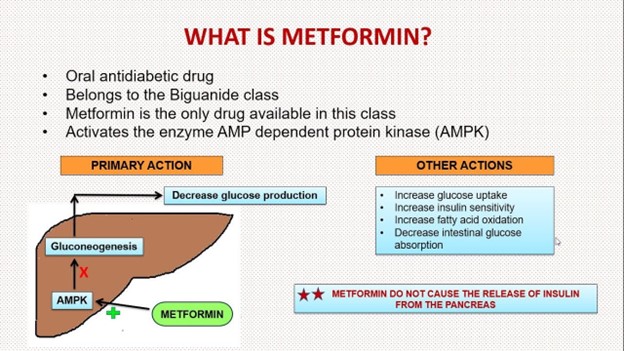A nurse accidently administers the medication metformin instead of metoprolol to a client. Which of the following actions should the nurse take?
Obtain the client's HDL level.
Check the client's glucose level.
Monitor the client's thyroid function levels.
Collect the client's uric acid level.
The Correct Answer is B
A. Obtain the client's HDL level.
Explanation: This choice is not relevant to the situation. HDL (High-Density Lipoprotein) level is related to cholesterol levels and cardiovascular health, which is not directly affected by the administration of metformin instead of metoprolol.
B. Check the client's glucose level.
Explanation: Correct Choice. Metformin is an oral antidiabetic medication commonly used to lower blood glucose levels in individuals with type 2 diabetes. It works by improving insulin sensitivity and decreasing glucose production in the liver. Accidentally administering metformin instead of metoprolol could lead to hypoglycemia (low blood sugar) or other adverse effects related to glucose levels. Checking the client's glucose level is essential to assess and address any potential issues arising from this medication error.
C. Monitor the client's thyroid function levels.
Explanation: This choice is not directly relevant to the situation. Metformin and metoprolol do not significantly affect thyroid function levels. Thyroid function monitoring would not be the immediate concern in this scenario.
D. Collect the client's uric acid level.
Explanation: This choice is not directly relevant to the situation. Metformin and metoprolol do not have a primary impact on uric acid levels. Collecting the uric acid level would not be a priority in this context.

Nursing Test Bank
Naxlex Comprehensive Predictor Exams
Related Questions
Correct Answer is D
Explanation
A. Another formulation of potassium should be given IV: The type of potassium formulation isn't the issue in this scenario.
B. Potassium chloride should be diluted in dextrose 5% in water: While potassium chloride can be administered in different solutions, the primary concern here is the infusion rate, not the specific diluent.
C. The client should be treated by giving potassium by IV bolus: The concern here is the rate of administration, not the route. Potassium is commonly administered through an IV infusion rather than a bolus due to the risk of cardiac arrhythmias associated with rapid administration.
D. A nurse is caring for a client who is to receive potassium replacement. The nurse should clarify the prescription with the provider because the potassium infusion rate is too rapid.
The prescription indicates that the client should receive potassium chloride 30 mEq in 0.9% sodium chloride 100 mL IV over 30 minutes. This rate of administration is too fast for potassium replacement and could lead to potentially serious complications, such as hyperkalemia or cardiac arrhythmias. The typical recommended rate for potassium replacement is 10-20 mEq/hour, and this prescription exceeds that range.
Correct Answer is C
Explanation
A. Naloxone IV:
This choice is incorrect. Naloxone is an opioid receptor antagonist used to reverse the effects of opioid overdose. It works by displacing opioids from the receptors and rapidly reversing their effects. However, in this scenario, the client is experiencing pain 1 hour after receiving morphine, indicating that the morphine's analgesic effects have likely worn off. Naloxone is not used to manage pain, but rather to reverse opioid overdose.
B. Fentanyl transmucosal:
This choice is incorrect. Fentanyl transmucosal formulations are used for breakthrough pain in opioid-tolerant patients with chronic pain conditions. It is not typically the first choice for immediate pain relief after intravenous morphine administration. Additionally, it's worth noting that fentanyl transmucosal products, like fentanyl lollipops, are usually reserved for chronic pain management and may not be suitable for immediate post-administration pain relief.
C. Morphine tablet:
This is the correct choice. If the client is experiencing pain 1 hour after receiving morphine intravenously, it's reasonable to administer an oral or sublingual form of morphine for continued pain relief. Morphine tablets are commonly used for pain management and can provide sustained relief over a longer duration. This choice aligns with the patient's initial prescription for pain control.
D. Lidocaine patch:
This choice is incorrect. Lidocaine patches are used to manage localized neuropathic pain, such as postherpetic neuralgia. They work by numbing the skin and underlying tissues in the area where they are applied. While lidocaine patches can be effective for certain types of pain, they are not typically used to address the acute pain associated with cancer and immediate post-administration pain relief.
Whether you are a student looking to ace your exams or a practicing nurse seeking to enhance your expertise , our nursing education contents will empower you with the confidence and competence to make a difference in the lives of patients and become a respected leader in the healthcare field.
Visit Naxlex, invest in your future and unlock endless possibilities with our unparalleled nursing education contents today
Report Wrong Answer on the Current Question
Do you disagree with the answer? If yes, what is your expected answer? Explain.
Kindly be descriptive with the issue you are facing.
